Haryana: Assembly elections
This is a collection of articles archived for the excellence of their content. |
Contents |
The results
1996-2014

From: Sep 22, 2019: The Times of India

From: Sep 22, 2019: The Times of India
See graphics:
The results of the Haryana assembly elections, 1996-2000
The results of the Haryana assembly elections, 2005-2014
1969-2019

From: Shyamlal Yadav, Oct 8, 2024: The Indian Express
See graphic:
The Haryana Assembly elections, 1969-2019: the winners, the runner up and the second runner up
2019-2024
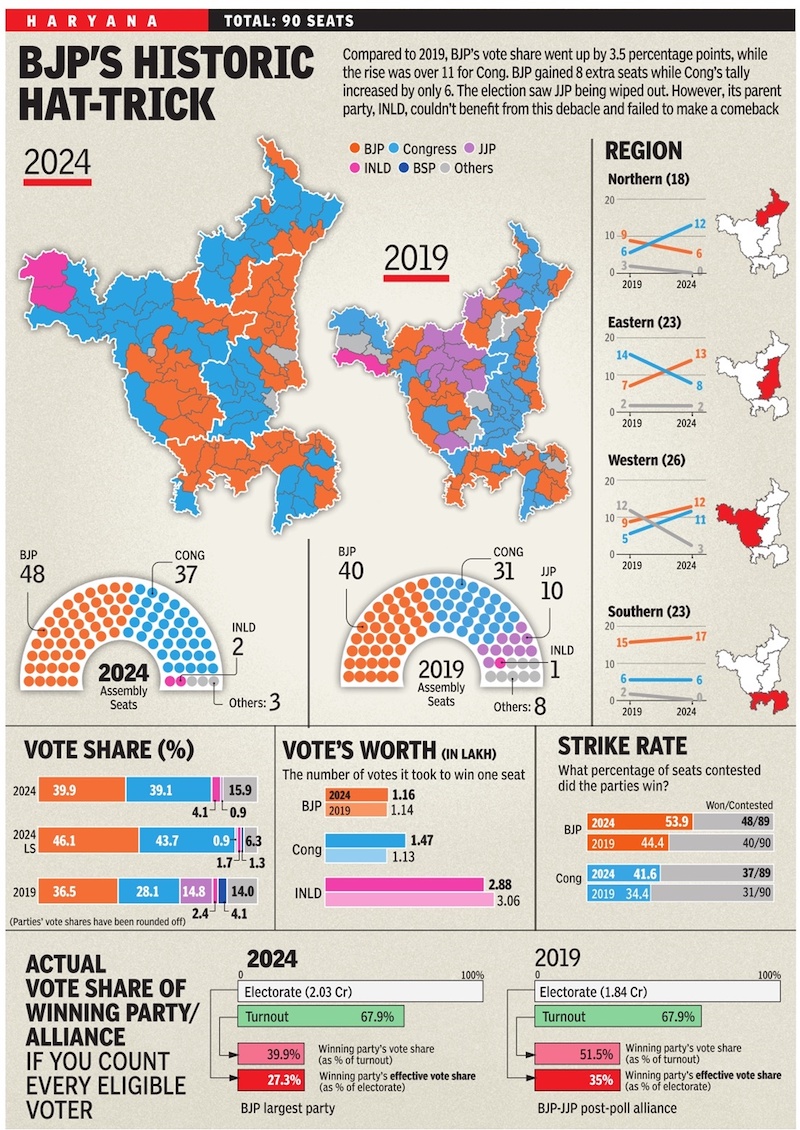
From: Oct 9, 2024: The Times of India
See graphic:
Vote share, seats, 2019-2024, Haryana Legislative Assembly elections
2019
An overview of the results
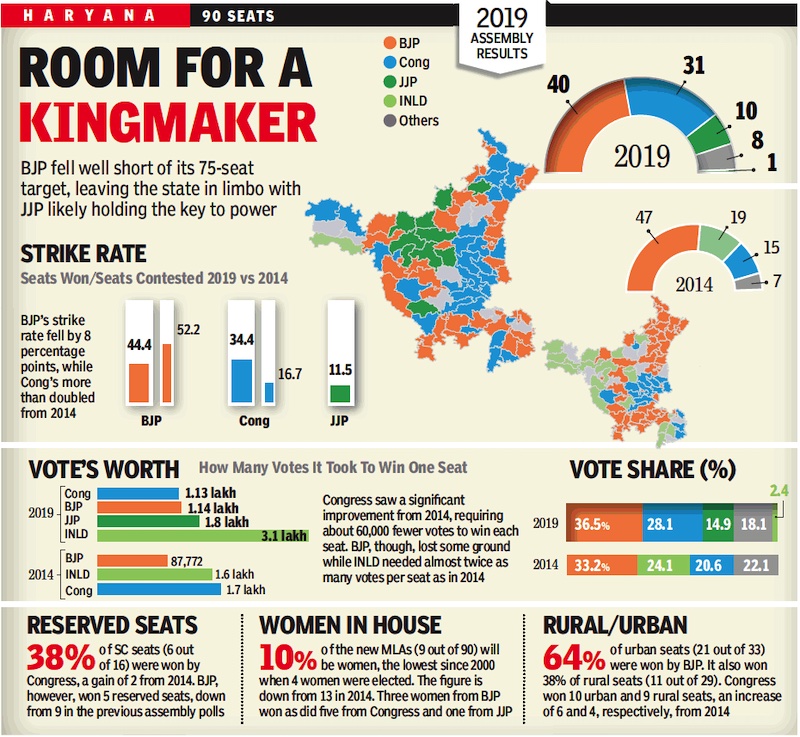
From: Oct 25, 2019: The Times of India
See graphic:
The results of the Haryana assembly elections, 2019: an overview
The results explained
Oct 25, 2019: The Times of India

From: Oct 25, 2019: The Times of India
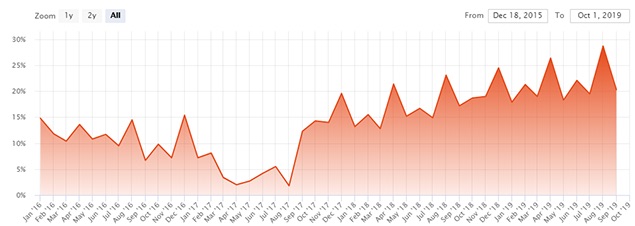
From: Oct 25, 2019: The Times of India
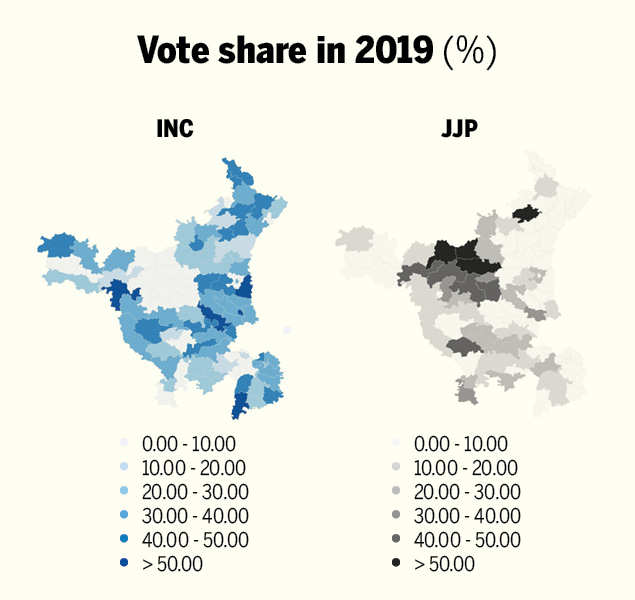
From: Oct 25, 2019: The Times of India

From: Oct 25, 2019: The Times of India

From: Oct 25, 2019: The Times of India

From: Oct 25, 2019: The Times of India
See graphics:
Unemployment in Haryana (%) and India (%), August 2016- August 2019
Unemployment in Haryana, December 18, 2015- October 1, 2019
Vote share in Haryana, INC and JJP, 2019
Seats won by different political parties in urban areas in Haryana, 2014- 2019
Seats won by different political parties in rural areas in Haryana, 2014- 2019
Winning margin less than 2,000 votes in Haryana
1. Rising unemployment, economic slowdown hurt BJP
A slowing economy and increasing unemployment dented BJP’s prospects, particularly in Haryana. The state has the highest unemployment rate in the country — three and a half times the national average.
In its 2014 manifesto, BJP promised lakhs of jobs to the unemployed, but it's failed miserably in delivering on its promise, with more than 16 lakh educated unemployed youth in the state. The state, where two-thirds of India’s passenger cars and 60% of its two-wheelers are manufactured, has struggled due to the economic slowdown with the auto sector bearing the brunt. Auto sales declined for the eleventh straight month in September with a 24% drop. The result — up to 50,000 workers have lost their jobs in the Gurgaon-Manesar auto belt alone.
2. The Jat factor in Haryana
Jats comprise 28% of the state’s population and 25% of its electorate. In the Lok Sabha elections held earlier this year, the saffron party made a clean sweep by winning all seats. In this state election, BJP went to the polls under the leadership of its CM Manohar Lal Khattar, from the state's minority Punjabi community, while Congress and Jannayak Janata Party (JJP) were headed by Jat leaders — former CM Bhupinder Singh Hooda and Dushyant Chautala, the great grandson of former deputy PM Devi Lal, respectively.
In 32 seats with a sizeable Jat population, the BJP won 8 (down one seat from 2014), while in non-Jat areas, the party won 32 out of 48 seats.
But it was INLD that was hit the hardest, witnessing a decline of 8 seats and a significant drop of almost 23% in its vote share. This meant that the Jat vote shifted to the Congress and the JJP, both gaining 4 seats each at INLD’s expense. A possible tactical understanding between JJP and Congress, similar to BJP's strategy in Karnataka where it did not field strong candidates in JD(S) strongholds, may have also contributed to the former's good show. Contrary to expectations, Hooda and Dushyant did not end up cutting into each other’s vote banks which the BJP had banked upon.
The Jat quota issue, in particular, appears to have dented Khattar's prospects. Though his government did accede to Jat demands, granting them 10% reservation, the decision was stayed by the high court.
3. BJP clear winner in urban areas, lags in rural seats
In Haryana, BJP won 20 of the state’s 31 urban seats (64%), and the Congress bagged 6 seats in urban areas. BJP won just 20 out of 59 rural seats in the state. While attention to connectivity worked for Khattar, poor civic governance proved a dampener.
4. Haryana, where victory margin is less than 2,000
In the 90-member Haryana assembly, there were nine seats where the winning candidate won with a margin of less than 2,000 votes -- four each to the Congress and BJP, respectively, and one to Gopal Kanda of the Haryana Lokhit Party. The smallest victory margin in the state was at Sirsa, where Kanda defeated Independent candidate Gokul Setia by 602 votes.
Winners, Losers

From: Oct 25, 2019: The Times of India

From: Oct 25, 2019: The Times of India
See graphics:
Notable winners and losers in the Haryana assembly elections, 2019: NCR
Notable winners and losers in the Haryana assembly elections, 2019
Faridabad
Bagish Jha , Oct 25, 2019: The Times of India

From: Bagish Jha , Oct 25, 2019: The Times of India
BJP won four out of six seats in Faridabad district, while two seats — Faridabad NIT and Prithla — went to Congress’ Neeraj Sharma and Independent candidate and BJP rebel Nayan Pal Rawat.
In 2014, BJP had won three seats while Congress, INLD and BSP had won one seat each.
Industry and environment minister Vipul Goel was denied a ticket for Faridabad seat which initially led to discontent within the party. However, this did not dent the party’s performance as Narendra Gupta defeated Congress rival LS Singla by 21,713 votes.
“We have improved our performance in the region. Congress has won just one seat with a narrow margin of over 3,000 votes in Faridabad NIT,” said Faridabad MP KP Gujjar.
BJP chose a lesser-known face, Sohan Pal Chhokar, over Rawat for Prithla, leading to rebellion which ate into the party’s vote share, feel political observers. Its nominee Sohan Pal won only 21,322 votes (14.5%) and came a distant third.
In Ballabgarh, from where PM Narendra Modi kicked off his Haryana campaign, BJP’s Mool Chand Sharma got 66,708 votes (54.42%) and retained the seat, defeating Congress rival Anand Kaushik, who got 24,995 votes (20.39%).
BJP wrested Tigaon seat from Congress, with Rajesh Nagar defeating Lalit Nagar by 33,841 votes. BJP’s Seema Trikha retained the Badhkal with 58,550 votes against Congress’ Vijay Pratap Singh, who got 56,005 votes. In Faridabad NIT, Congress’ Neeraj Sharma got 61,697 votes (38.36%) and defeated his nearest rival Nagendra Bhadana of BJP, who got 58,455 votes(36.82%).
BJP gains in Palwal
The Palwal seat was won by BJP’s Deepak Mangla, advisor to the CM, who defeated Karan Singh of Congress by 28,296 votes. Congress had won this seat in 2014. BJP also won from both Hodal (SC) and Hathin by 3,387 and 2,887 votes, respectively, defeating Congress. In 2014, BJP had lost all three seats.
Gurgaon, Badshapur
Joel Joseph , Oct 25, 2019: The Times of India

From: Joel Joseph , Oct 25, 2019: The Times of India
Three of the four seats in Gurgaon district went with BJP, but the state’s largest constituency in terms of number of voters chose an Independent.
Badshapur, considered a stronghold of minister Rao Narbir Singh who had won the seat handsomely in 2014, voted this time for Independent Rakesh Daultabad, who had campaigned extensively on civic issues like water and roads. BJP insiders believe Daultabad would eventually help the party form the government, though he himself has denied it firmly.
BJP won the three other seats in the district — Gurgaon, Sohna and Pataudi — but the loss in Badshapur raised questions about the party’s decision to field a debutant Manish Yadav in place of Narbir, known to wield considerable influence among the Yadavs, who make up most of the electorate.
Political analysts believe a wide section of the electorate was aggrieved with BJP over its decision not to give the ticket to Narbir. Some have even argued that a section of the electorate, which would otherwise have voted Narbir, had chosen to cast their franchise in favour of Daultabad.
What could have helped Daultabad is his extensive campaign on civic issues. Most of his rallies focused on issues such as roads, electricity and water, which directly affect voters. A majority of the electorate in Badshapur are from the new sectors like Sohna Road, Golf Course Road, Southern Peripheral Road and Dwarka Expressway, where civic issues are a cause for concern. One of the major demands for these residents is the shifting of the Kherki Daula toll plaza, if not removing it completely.
By the end of day, Daultabad had bagged 10,186 votes more than BJP’s Manish. Though a Yadav himself, Manish is not known to be popular in the community. In the 2014 polls, Narbir had won Badshapur by a margin of more than 18,000 votes. In the other seats, however, BJP sailed through. Satya Prakash Jarawata won from Pataudi with a margin of 36,579 votes, while Sudhir Singla bagged the Gurgaon seat by 33,315 votes. Sanjay Singh won Sohna by 12,453 votes. In Gurgaon, however, Independent candidate Mohit Grover bagged 33% of the total votes polled, much ahead of Congress’s 12%. BJP’s vote share, on the other hand, fell 13 percentage points to 43%.
The party had its share of challenges for the Gurgaon seat as well. Since a majority of the Gurgaon population are not registered voters in the seat, BJP’s campaign largely bypassed civic problems — something voters were aggrieved with.
BJP, which chose to field fresh faces, also had to battle discontent over distribution of tickets. But Congress, the primary opposition party, failed to capitalise on these issues. In fact, it was Independents who trumped Congress for the second spot in Pataudi and Gurgaon, while JJP’s Rohtas Khatana, the richest candidate this time, came second in Sohna. Khatana, experts believe, had a strong chance of winning from Sohna.
But Dalit votes are believed to have got consolidated after a rally by BSP supremo Mayawai in favour of party candidate Javed Khan, which cost Khatana dearly.
The first few hours of counting threw up a neck and neck contest for the Gurgaon seat, made up primarily of Punjabi voters. BJP, which had won the Gurgaon seat by a record margin of 84,000 votes in 2014, had ruffled feathers when it chose to replace Umesh Aggarwal with Sudhir Singla from the Baniya community.
The counting went well beyond 4.30 pm, and Aggarwal defeated Independent Mohit Griver by around 33,000 votes. Emerging out of the counting centre in Badshapur, Daultabad denied he would back BJP. A BJP functionary, however, suggested otherwise. He said it was his party that had won Badshapur, hinting that Daultabad had given his assent.
Mewat
Shubhra.Pant , Oct 25, 2019: The Times of India

From: Shubhra.Pant , Oct 25, 2019: The Times of India
BJP’s attempts to make inroads into the Muslim-dominated district of Mewat remained unsuccessful as Congress won all the three seats — Ferozepur-Jhirka, Punhana and Nuh.
While Congress candidate Mamman Khan comfortably won from Ferozepur-Jhirka, defeating his nearest rival Naseem Ahmed of BJP by 37,004 votes, it was a close contest in Nuh and Punhana. In Nuh, Congress candidate Aftab Ahmed, who is also the party state vice-president, won by 4,038 votes, defeating outgoing MLA and BJP candidate Zakir Hussain. The fight in Punhana was tighter, with Congress’ Mohammad Ilyas defeating Independent candidate Rahish Khan by just 816 votes.
Expressing happiness over the results, Aftab Ahmed told TOI, “BJP is known for marketing and their claims fell flat. They have duped the public for the last five years and that is why the mandate is against them.”
Taking a dig at his opponent Zakir Hussain, he added, “BJP had imported multiple leaders from other parties. The results have shown the mirror to all of them.”
Hussain was earlier with Indian National Lok Dal (INLD) and had won by a margin of over 32,796 votes in the previous election from Nuh defeating Aftab Ahmed.
In Punhana as well, BJP’s move to field Nauksham Chaudhary, who returned from London and recently joined Haryana politics, failed to make any impact as she was placed third after Ilyas and Khan. Ilyas gave credit to the Congress high command, saying they “took the decision to give the reins to state chief Kumari Selja and Bhupinder Singh Hooda at the right time which led to the party’s victory in Mewat”.
Rahish Khan had won as an independent from Punhana in the last election.
He went on to join BJP but ended up fighting again as an Independent after failing to get a ticket from the party.
For Mamman Khan, it was a significant breakthrough in Ferozepur-Jhirka, where he had lost the previous two elections. Talking about his victory, he told TOI, “I am thankful to the people of the area for electing me with such a huge margin. I will make sure that we address the problems of canal water availability and unemployment.”
BJP spokespersons could not be reached for a comment on the party’s performance in the district. However, locals said BJP lost due to its image of being an anti-Muslim party and the high number of cow vigilantism cases that were reported from here in the past five years.
NCR/ areas close to Delhi

From: Oct 25, 2019: The Times of India
See graphic:
How Delhi’s Neighbours in Haryana Voted
Sonipat
Siddharth Tiwari , Oct 25, 2019: The Times of India
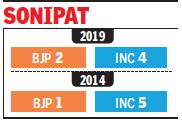
From: Siddharth Tiwari , Oct 25, 2019: The Times of India
Congress has managed to retain its bastion of Sonipat, albeit with a minor dent, winning four of the six seats in the district. BJP, which had won only one seat last time, has increased its tally to two, while INLD has been completely routed.
The Jat heartland, which was at the centre of a violent quota agitation in 2016, had given Congress five seats last time. Although BJP tried to strategically field Jat candidates, it did not work in its favour.
The most decisive victory for Congress came from Sonipat seat, where Surender Panwar defeated two-time MLA Kavita Jain with an impressive margin of over 30,000 votes. BJP was banking on Brahmins, Punjabi and Baniya votes but Panwar’s popularity among the masses won the day for Congress. From distributing free helmets to organising religious tours for economically weaker sections, Panwar has earned goodwill for his philanthropy.
In Gohana, voters re-elected Congress’ Jagbir Singh Malik, who defeated LSP’s Raj Kumar Saini by over 4,000 votes. Voters were visibly upset with the ruling government. A sore point was the loss of a railway coach factory to the PM’s constituency, Varanasi.
In Baroda, Congress’ Krishan Pal Hooda won a third consecutive term, defeating BJP’s Yogeshwar Dutt by 4,840 votes. JJP, which had fielded Bhupinder Malik, also failed to make inroads.
Kharkhoda (SC) seat saw a close contest, with Congress candidate Jaiveer Singh defeating JJP’s Pawan Kumar by 1,544 votes.
For BJP, the decisive victory came in Ganaur, where it had fielded INLD’s turncoat Nirmal Rani. Helped by antiincumbency and transfer of INLD votes, Rani defeated Congress candidate Kuldeep Sharma by over 10,000 votes.
Rai, where migrants are in majority, was expected to overwhelmingly vote for BJP. However, it was a neck and neck fight, with BJP’s Mohan Lal Badoli managing only a slim victory margin of 2,662 votes over Congress candidate Jai Tirath Dahiya.
Political expert Ramji Lal said, “JJP was playing spoilsport in the district and BJP was hoping to gain from the division of Jat votes. Yet, Congress largely managed to foil these attempts. Ganaur was the only surprise, that too mainly because the INLD votes went to BJP because of the candidate (Nirmal Rani).”
Experts have argued that had Congress started campaigning and mobilising voters right after the Lok Sabha elections concluded, the party could have won at least five seats, if not all six. BJP’s wins in Rai and Ganaur are partly due to JJP playing spoiler, they added.
“This mandate comes after very little effort was made by Congress to woo voters. They only went with Congress because of their resentment towards BJP. In Sonipat seat, BJP lost with a huge margin because the Congress candidate (Panwar) has been active there for a while now,” noted senior political analyst Kushal Pal.
Indian National Lok Dal crashes
Ajay Sura , Oct 25, 2019: The Times of India
Once Haryana’s main opposition party, Indian National Lok Dal (INLD) led by Om Prakash Chautala emerged the worst performer in the state this time. As the party could win only one seat and its vote share is less than 3%, it is likely to lose its status as a recognised regional party. A political outfit requires to win a minimum of 6% of votes to be registered as a recognised party and cancellation of this recognition would lead to withdrawal of its symbol allotted by the Election Commission.
Except Ellenabad in Sirsa district where senior INLD leader Abhay Chautala won, and Yamunanagar where the party’s candidate Dilbag Singh lost by a thin margin, all INLD candidates lost their security deposits. None of the INLD candidates, apart from Abhay and Dilbag Singh, was in direct contention on any seat in the state.
This time, INLD even failed to field candidates on all the 90 seats. Many of its nominees even withdrew their candidature during the poll campaign in favour of other parties.
The party had ruled Haryana from 1999 to 2004 and was a recognised opposition party from 2009 to 2019. The decimation of INLD can be directly attributed to JJP, its splinter group formed by Ajay Chautala and his son Dushyant.
Demographics

From: Oct 25, 2019: The Times of India
See graphic:
The demographics of the Haryana legislative assembly, 2019
2024
Oct 9, 2024: The Times of India
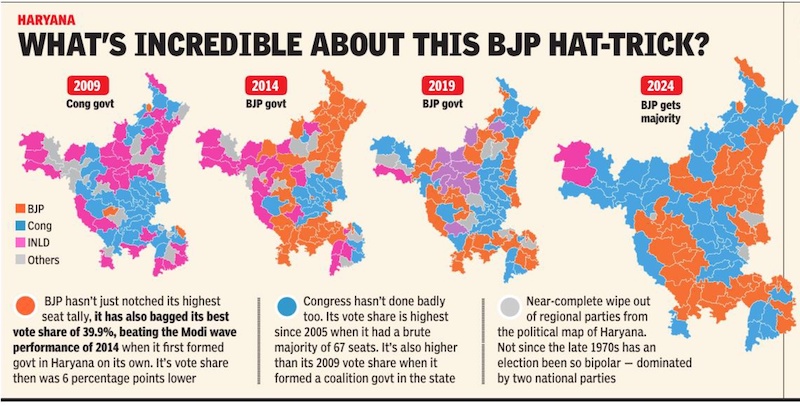
From: Oct 9, 2024: The Times of India
HARYANA : WHAT CAUSED THE AKHARA UPSET
MEMORIES OF HOODA RAJ
The decadelong (2004-2014) rule of state Congress boss was not known for probity, a level playing field for all castes, regional balance or justice or fair treatment of Dalits. Voters, it appeared, hadn’t forgotten what poll pundits had — those allegedly shady land deals, legions of ‘cash-forjobs’ stories, apparent favouritism towards Jats from Hooda’s Rohtak-Jhajjar stronghold, highhanded treatment of lower castes in incidents like those in Mirchpur. That Congress high command virtually handed over the state party to him this time as well helped reinforce those memories – and led even a section of voters who had supported Congress in LS polls to vote against it this time.
POST-LS SWAGGER-I
Congress’s five Lok Sabha seats, which came on the back of a 15 percentage point rise in vote share, made it think the assembly election was its for the taking. Hubris often breeds complacency, and it was complacency that made the Congress high command agree to a Hooda father-son play as its main strategy. Aside from upsetting non-Jats, the virtual handing over of the campaign to Hoodas sharpened party infighting.
POST-LS SWAGGER-II
Supremely confident of his comeback and eager to ensure that there were enough of his loyalists among MLAs to guard against any trouble, Hooda got most sitting MLAs re-nominated, many of whom were unpopular at local levels. This was akin to a gift to BJP, which fielded many new faces.
THE SELJA FACTOR
The marginalisation of Kumari Selja, at Hooda’s insistence, unravelled the Jat-Jatav compact that had worked well for Congress in Lok Sabha elections. Despite the preponderance of Jatavs in the list for reserved candidates, doubts about Selja’s status remained, especially as she publicly vented her grievances. The Gandhis, both in public and private, tried to bring her on board. But it never quite worked. Naturally, Modi and every BJP member highlighted this dissonance.
JAWAN/KISAN/ PEHALWAN WHO?
This rhetorical threesome proved effective for Congress in LS elections. But it failed in assembly polls. BJP’s promises to retiring Agniveers blunted the jawan plank. Many Haryana farmers have more diversified income sources than their cereal-dependant Punjab cousins — that weakened the pitch for farmers. Yes, Vinesh Phogat, the poster girl of the pehalwan agitation, won. But her narrow majority shows that while many Jats voted for Congress, a not insubstantial number went for BJP.
KHARCHI-PARCHI
Few outside Haryana could have made sense of the twin terms when Modi used them at one of his election meetings. But for large sections in Haryana it was a reminder of the cash-for-jobs scheme the state had become notorious for in the 10 years of Hooda CM-ship and the five years before that when Om Prakash Chautala was the CM. Govt recruitments under BJP were seen as an improvement. It was certainly not a system where governing party MLAs were given ‘targets’ of finding paying candidates for govt jobs. Congress’s campaign on unemployment had to contend with this problem.
BJP’S 2014 PLAYBOOK, BACK IN 2024
The party stuck to Amit Shah’s 2014 strategy of relying on 36 biradaris or castes to counter Congress’s strategy of relying on influential Jats, the largest community. Fears of Hooda hegemony helped this BJP strategy. Many non-Jat castes set aside disaffection over economic issues and focussed on countering a Jat wave. But a plain vanilla replay of this plan would have partially backfired for BJP, which does have some support among Jats who like Modi’s brand of muscular Hindu nationalism. So, the party spread the message on Jat hegemony quietly, never making it a part of its campaign speeches. Clearly, the message was heard by non-Jats.
MODI MATTERS
LS elections may have dimmed his political aura somewhat but in a state where cow ‘protection’ forces are a visible presence and ‘strong’ members play well, the PM, even with minimal campaigning, remains a brand to be reckoned with. At the margin, BJP benefitted from being Modi’s party.
SMART AND SAINI DECISION
When BJP replaced ML Khattar with Nayab Singh Saini, pundits’ verdict was mixed. But results showed it was the smartest call BJP made in Haryana. The very fact Saini was neither as high profile nor as headline-hogging as Khattar helped the party. Saini’s amiability was seen by many Haryana voters as a decided improvement on Khattar’s periodic acerbic remarks. That same quality, as also the fact that Saini comes from the ‘36-biradari group’, helped the CM when he campaigned among a variety of nonJat castes. There was a danger that Khattar’s sacking would anger his fellow Punjabis. But his prime Union cabinet portfolios of power and urban development nixed any idea that he was being sidelined completely.
SLICE AND DICE DALIT QUOTA
BJP in Haryana openly supported the demand that the SC verdict okaying subcategorisation of Dailts’ quota be made policy. The issue has strong resonance among large sections of Dalits, who have long held a grudge that Jatavs have been the largest beneficiary of quotas. Congress was hamstrung on this. It couldn’t have supported such a policy for fear of annoying Jatavs, who got the largest share of Congress tickets for reserved seats.
BETTER RESPONSE
BJP was perhaps a bit tone-deaf on the Agnipath scheme during LS polls. In assembly polls, the party course-corrected, promised jobs for recruits who would have to leave after a short service. It also made comforting noises on assured price support, closely mirroring MSP — the target being farmers. Not just in policy terms, BJP responded better to political challenges as well. Dropping sitting MLAs and heavyweights, including former state chief Ramvilas Sharma, worked out, as did prompt firefighting when dissidence surfaced.